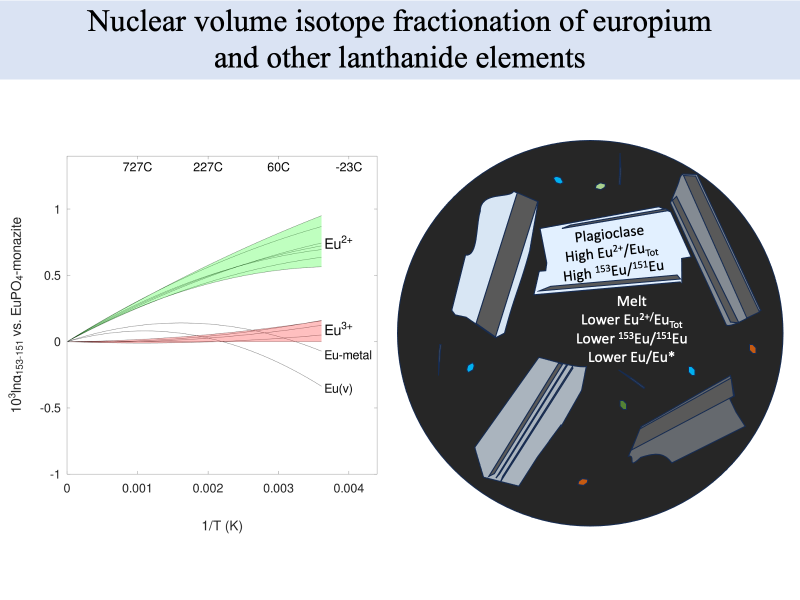
Nuclear volume isotope fractionation of europium and other lanthanide elements
ABSTRACT

The nuclear volume component of equilibrium field shift isotope fractionations in europium and other lanthanide elements is estimated using Mössbauer spectroscopy and electronic structure calculations. This effect goes in the opposite direction from equilibrium mass-dependent fractionation, and in the case of europium is predicted to dominate over mass dependent fractionation for most materials. Including both effects, Eu2+-bearing species will have approximately 0.4–1‰ higher 153Eu/151Eu than Eu3+-bearing species at 298 K (25°C), and about 0.3‰ higher 153Eu/151Eu at 973 K (700°C). Field shift fractionation mainly depends on oxidation state; differences in coordination structure without changes in oxidation state appear to have much weaker associated fractionations. Nuclear volume isotope fractionation will become even more dominant over mass dependent fractionation at higher temperatures because nuclear volume effects scale with 1/T (K), vs. 1/T2 for mass-dependent fractionation. Fractionation favoring high 153Eu/151Eu in minerals that preferentially incorporate Eu2+, such as plagioclase, is consistent with recent measurements on igneous rocks showing low 153Eu/151Eu in samples with large negative europium anomalies (Lee and Tanaka, 2021). The present results agree with the recent conclusion that equilibrium fractionation cannot explain cosmochemical REE fractionations in primitive meteoritical materials (Hu et al., 2021), because the net fractionation is too small (~0.2‰ or less) at temperatures >1200 K where vapor-phase REE species are relevant.
KEYWORDS
Keywords: Europium isotopes, cerium isotopes, nuclear field shift, rare earth element isotope fractionation, europium anomaly- Published : 2023
- Released on J-STAGE : 2023/07/12
- Received : 2023/03/24
- Accepted : 2023/05/24
- DOI : https://doi.org/10.2343/geochemj.GJ23010
- J-STAGE URL : https://www.jstage.jst.go.jp/article/geochemj/57/4/57_GJ23010/_article/-char/en
- J-Online ISSN: 1880-5973
- Print ISSN : 0016-7002
- ISSN-L : 0016-7002
All Issues
- Vol.59, 2025
- Vol.58, 2024
- Vol.57, 2023
- Vol.56, 2022
- Vol.55, 2021
- Vol.54, 2020
- Vol.53, 2019
- Vol.52, 2018
- Vol.51, 2017
- Vol.50, 2016
- Vol.49, 2015
- Vol.48, 2014
- Vol.47, 2013
- Vol.46, 2012
- Vol.45, 2011
- Vol.44, 2010
- Vol.43, 2009
- Vol.42, 2008
- Vol.41, 2007
- Vol.40, 2006
- Vol.39, 2005
- Vol.38, 2004
- Vol.37, 2003
- Vol.36, 2002
- Vol.35, 2001
- Vol.34, 2000
- Vol.33, 1999
- Vol.32, 1998
- Vol.31, 1997
- Vol.30, 1996
- Vol.29, 1995
- Vol.28, 1994
- Vol.27, 1993
- Vol.26, 1992
- Vol.25, 1991
- Vol.24, 1990
- Vol.23, 1989
- Vol.22, 1988
- Vol.21, 1987
- Vol.20, 1986
- Vol.19, 1985-1986
- Vol.18, 1984
- Vol.17, 1983
- Vol.16, 1982
- Vol.15, 1981
- Vol.14, 1980
- Vol.13, 1979
- Vol.12, 1978
- Vol.11, 1977
- Vol.10, 1976
- Vol.9, 1975
- Vol.8, 1974
- Vol.7, 1973
- Vol.6, 1972-1973
- Vol.5, 1971
- Vol.4, 1970-1971
- Vol.3, 1969-1970
- Vol.2, 1968
- Vol.1, 1966-1967




